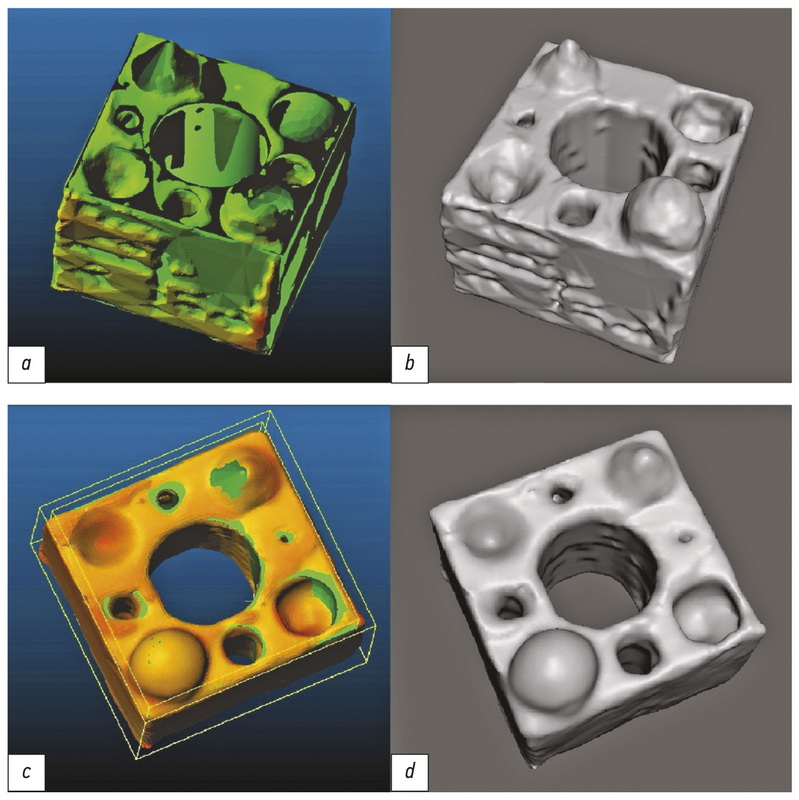Evaluation of geometric deviations in rapid prototyped three-dimensional models created from computed tomography data
- Authors: Shirshin A.V.1,2, Zheleznyak I.S.1, Malakhovsky V.N.1, Kushnarev S.V.1, Gorina N.S.1
-
Affiliations:
- Kirov Military Medical Academy
- ITMO University
- Issue: Vol 2, No 3 (2021)
- Pages: 277-288
- Section: Technical Reports
- URL: https://journals.rcsi.science/DD/article/view/63680
- DOI: https://doi.org/10.17816/DD63680
- ID: 63680
Cite item
Abstract
BACKGROUND: Computer-aided design and three-dimensional printing have been used in various clinical and fundamental medicine fields, especially in surgery. For example, in the preoperative period, the correspondence of printed products to the anatomy can play an important role in evaluating pathological changes and correction methods. However, determining dimensional deviations of printed models involves ethical and technical difficulties associated with defining a reference and taking many measurements, respectively. Therefore, we propose to use a geometric object with known dimensions as a reference and estimate linear deviations using the Iterative Closest Point algorithm for each of the vertices of the prototyped polygonal mesh.
AIMS: To evaluate the geometric deviations associated with creation of bone-like physical objects from computed tomography data using computer-aided design and additive manufacturing.
MATERIALS AND METHODS: The source object was created using the FreeCAD application; Blender and Meshmixer software was used for polygon meshes correction and transformation. The 3D printing was carried out on an Ender-3 printer with copper-impregnated polylactide plastic BFCopper. Scanning was performed using a 128-slice tomograph Philips Ingenuity CT. A series of tomographic images were processed in 3DSlicer software to create virtual models by semiautomatic segmentation with threshold values of 500 HU, 0 HU, −500 HU, −750 HU, and manual segmentation. Reproduced and reference polygon meshes were compared using the Iterative Closest Point algorithm in CloudCompare software.
RESULTS: The volume of reproduced models exceeded the volume of respective reference models by 1%–27%. The average point cloud linear deviation values of reproduced models from the reference ones were 0.03–0.41 mm. A significant correlation between integral sums of linear deviations and changes in the volume of reproduced models was shown using Spearman's rank correlation coefficient (ρ = 0.83; temp = 5.27, p=0.05).
CONCLUSION: The geometry of the reproduced object changes inevitably, while the linear deviations depend more on the chosen segmentation method than on the overall size of the model or its structures. The manual segmentation method can lead to greater linear deviations, though it saves all the necessary anatomical structures.
Full Text
##article.viewOnOriginalSite##About the authors
Aleksandr V. Shirshin
Kirov Military Medical Academy; ITMO University
Author for correspondence.
Email: asmdot@gmail.com
ORCID iD: 0000-0002-1494-9626
SPIN-code: 4412-0498
Russian Federation, 6G, Akademika Lebedeva street, Saint-Petersburg, 194044; 49, Kronverksky pr., St. Petersburg, 197101
Igor S. Zheleznyak
Kirov Military Medical Academy
Email: igzh@bk.ru
ORCID iD: 0000-0001-7383-512X
SPIN-code: 1450-5053
MD, Dr. Sci. (Med.), Assistant Professor
Russian Federation, 6G, Akademika Lebedeva street, Saint-Petersburg, 194044Vladimir N. Malakhovsky
Kirov Military Medical Academy
Email: malakhovskyvova@gmail.com
ORCID iD: 0000-0002-0663-9345
SPIN-code: 2014-6335
MD, Dr. Sci. (Med.), Professor
Russian Federation, 6G, Akademika Lebedeva street, Saint-Petersburg, 194044Sergei V. Kushnarev
Kirov Military Medical Academy
Email: S.v.kushnarev@yandex.ru
ORCID iD: 0000-0003-2841-2990
SPIN-code: 5859-0480
MD, Cand. Sci. (Med.)
Russian Federation, 6G, Akademika Lebedeva street, Saint-Petersburg, 194044Natalia S. Gorina
Kirov Military Medical Academy
Email: natali_bgmu@mail.ru
ORCID iD: 0000-0002-6220-8195
SPIN-code: 8175-6746
Russian Federation, 6G, Akademika Lebedeva street, Saint-Petersburg, 194044
References
- Trauner KB. The emerging role of 3D printing in arthroplasty and orthopedics. J Arthroplasty. 2018;33(8):2352–2354. doi: 10.1016/j.arth.2018.02.033
- Randazzo M, Pisapia JM, Singh N, Thawani JP. 3D printing in neurosurgery: a systematic review. Surg Neurol Int. 2016;7(Suppl 33):S801–S809. doi: 10.4103/2152-7806.194059
- Meier LM, Meineri M, Qua Hiansen J, Horlick EM. Structural and congenital heart disease interventions: the role of three-dimensional printing. Neth Heart J. 2017;25(2):65–75. doi: 10.1007/s12471-016-0942-3
- Ochoa S, Segal J, Garcia N, Fischer EA. Three-dimensional printed cardiac models for focused cardiac ultrasound instruction. J Ultrasound Med. 2019;38(6):1405–1409. doi: 10.1002/jum.14818
- Takao H, Amemiya S, Shibata E, Ohtomo K. 3D printing of preoperative simulation models of a splenic artery aneurysm: precision and accuracy. Acad Radiol. 2017;24(5):650–653. doi: 10.1016/j.acra.2016.12.015
- Owen BD, Christensen GE, Reinhardt JM, Ryken TC. Rapid prototype patient-specific drill template for cervical pedicle screw placement. Comput Aided Surg. 2007;12(5):303–308. doi: 10.3109/10929080701662826
- Sánchez-Sánchez Á, Girón-Vallejo Ó, Ruiz-Pruneda R, et al. Three-dimensional printed model and virtual reconstruction: an extra tool for pediatric solid tumors surgery. European J Pediatr Surg Rep. 2018;6(1):e70–e76. doi: 10.1055/s-0038-1672165
- Choi JY, Choi JH, Kim NK, et al. Analysis of errors in medical rapid prototyping models. Int J Oral Maxillofac Surg. 2002;31(1): 23–32. doi: 10.1054/ijom.2000.0135
- Kwun JD, Kim HJ, Park J, et al. Open wedge high tibial osteotomy using three-dimensional printed models: Experimental analysis using porcine bone. Knee. 2017;24(1):16–22. doi: 10.1016/j.knee.2016.09.026
- Chung M, Radacsi N, Robert C, et al. On the optimization of low-cost FDM 3D printers for accurate replication of patient-specific abdominal aortic aneurysm geometry. Version 2. 3D Prin Med. 2018;4(1):2. doi: 10.1186/s41205-017-0023-2
- El-Katatny I, Masood SH, Morsi YS. Error analysis of FDM fabricated medical replicas. Rapid Prototyp J. 2010;16(1):36–43. doi: 10.1108/13552541011011695
- Salmi M, Paloheimo KS, Tuomi J, et al. Accuracy of medical models made by additive manufacturing (rapid manufacturing). J Craniomaxillofac Surg. 2013;41(7):603–609. doi: 10.1016/j.jcms.2012.11.041
- Mitsouras D, Liacouras P, Imanzadeh A, et al. Medical 3D printing for the radiologist. Radiographics. 2015;35(7):1965–1988. doi: 10.1148/rg.2015140320
- Dionísio FC, Oliveira LS, Hernandes MA, et al. Manual and semiautomatic segmentation of bone sarcomas on MRI have high similarity. Braz J Med Biol Res. 2020;53(2):e8962. doi: 10.1590/1414-431x20198962
- Parmar C, Rios Velazquez E, Leijenaar R, et al. Robust radiomics feature quantification using semiautomatic volumetric segmentation. PLoS One. 2014;9(7):e102107. doi: 10.1371/journal.pone.0102107
- De Lima Moreno JJ, Liedke GS, Soler R, et al. Imaging factors impacting on accuracy and radiation dose in 3D printing. J Maxillofac Oral Surg. 2018;17(4):582–587. doi: 10.1007/s12663-018-1098-z
- Narizzano M, Arnulfo G, Ricci S, et al. SEEG assistant: a 3DSlicer extension to support epilepsy surgery. BMC Bioinformatics. 2017;18(1):124. doi: 10.1186/s12859-017-1545-8
Supplementary files
















